Sketchbook 2, 1957-60
Sketchbook 2 deals primarily with Eunice Parsons' private life. During the time period of this sketchbook, she was employed as an art teacher by the YMCA and was teaching classes to young women on the art of landscapes and still lifes. This is reflected in her sketchbook through a more selective eye for landscapes, portraits and genre scenes. The images within this sketchbook revolve around creating compelling images that capture an essence of life. The methods through which Parsons chooses to convey this differ, but overall the theme of selection becomes dominant. She is selective not only in terms of the subject but also in media as well as line.
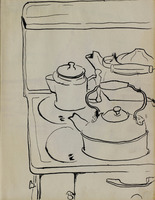
This sketchbook focuses on the everyday life of Eunice Parsons. Often times this means that the subject is less focused upon being art, and more so upon a sense of breaking through the banality of life. In this image, Parsons is taking pots on the stove and transforming it into an artwork. Her usage of line has improved and as a product, she is able to create more naturalistic images than in her previous sketchbook.
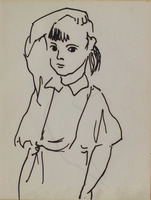
The highly personal nature of the portraits are, in this sketchbook, relatable to that of Annibale Carracci's early sketches of living models. There is a relaxed quality to the figures as if they were accustomed to being depicted by Parsons. These characters transform the sketchbook from a tool for practice into a journal of sorts where Parsons is able to document the people of her life through art.
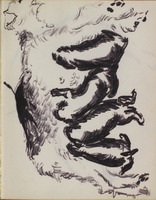
This scene of a female dog feeding her puppies is another example of Parsons taking directly from her everyday experience to create a work of art. It is not immediately clear what is being depicted, however, after a few moments the figures become identifiable. This method of creating ambiguous forms shows an interest in creating images that are more intellectually stimulating through the usage of differing rendering.
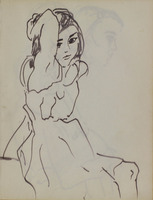
This portrait of a young girl is within the tradition of this sketchbook. The young girl is posed and seems to know that she is being sketched, with her gaze inviting the artist to continue their work. The figure is slightly older than the second image in this section, and could possibly be a family member or a student at the YWCA.
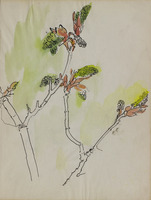
In the sketchbooks, Parsons rarely turns her attention to being botanically accurate, in the first sketchbook the trees and shrubs are minimal line drawings that only evoke the thought of a tree. However, this sketch of a plant seems much more accurate. It is unclear why this would be the case, as it is a fairly isolated incident. It is possible that Parsons was particularly interested in the color and the line, however, this is not certain.
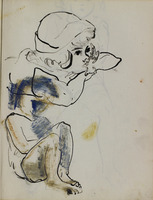
This sketch is an extension of the general tendency throughout these sketchbooks of Parsons' experimenting with mixing different mediums. With this image, in particular, the interplay of line, color, and medium can be seen as a precursor to the ideology behind later collages. In the lower of the two sketches of the young girl color and line become an alternative method to the purely figurative, substituting the reality of the sketch directly into abstraction. This substitution gives a new life to the figure, creating movement in an otherwise still image.
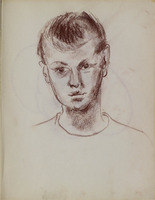
The attention to detail within this portrait shows a selection of what Parsons chose to be necessary. Much in the style of sketches by Annibale Carracci, this seems to be made directly from life, with a selective attention to the defining details that capture the essence of the sitter. This is in contrast to previous portraits within these sketchbooks, as Parsons has more often portrayed the entire character rather than a headshot. However, even in the cases where she has chosen to be selective in the part of the body, she has shown, generally, she has been more defined within her portrait. Here the lines of the head are highly sketchy, and the emphasis can be seen as being placed upon the expression and personality, rather than on the physical character.
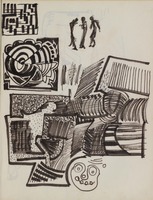
This image is especially interesting as it is one of the few sketches that do not seem to take their inspiration from nature, but more so from the concept of a previously existing artwork. In a sense, this is the intellectual precursor to the art of collage. Through the interpolation of stylistic elements, Parsons is choosing to create a simulacrum of a previously existing image or style. In much the same way, collage is the physical interpolation of these images as they exist in a new context, thus creating a simulacrum.
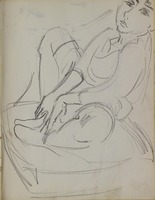
This incredibly expressive image shows the culmination of several tendencies that can be found throughout this sketchbook. Firstly it can be read as the move into the expressive from the naturalistic, a transition which occurred gradually over the course of this sketchbook and the end of the previous one. As a product of this process the sketch seems to be much more rapid, yet also more selective. Unlike the image 7, there is no attempt to create shadows to highlight the expressiveness of the character, but rather Parsons has adopted the gesture and the basic facial features to highlight the emotion that exists beyond the image. In a way, this can be read as a moving away from the purely retinal image towards something much more evocative and implied.
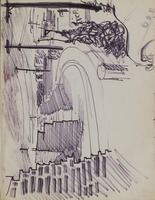
The landscape has been a strong recurrent theme within these sketchbooks and has generally followed some basic conventions. Many of these conventions can be found within this image. The trees are rendered with squiggles, much like her landscape of Philadelphia, the telephone poles are simply lines, and there is an almost atmospheric perspective as the figures fade into the distance. However, there are other influences present within this landscape. In relation to image 8, the buildings in the foreground seem to be more heavily outlined and much less rooted in a naturalistic realism. This image reflects a trend of Parsons moving towards a more stylized rendering of forms which could be the product of a synthesis of external influences. Rather than creating what she sees directly in front of her, Parsons has changed and begun creating what she sees in her mind through the lens of her own style.
